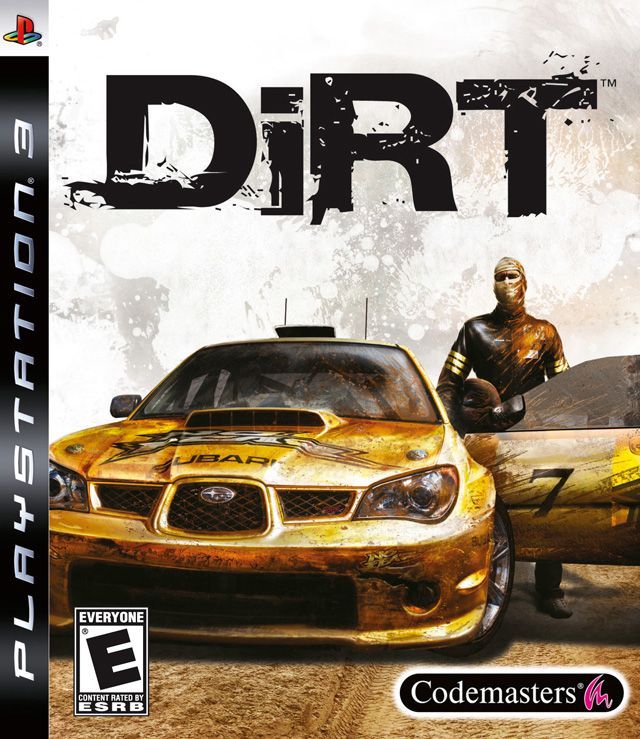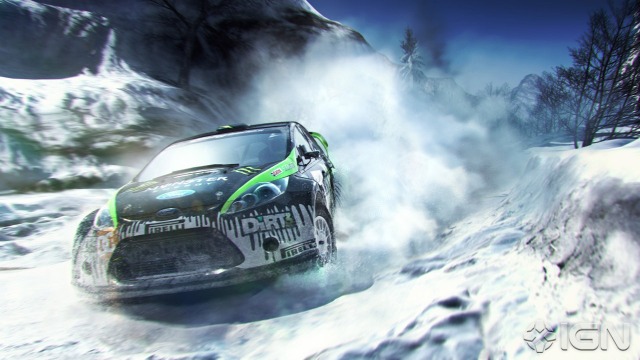There’s a good chance I’ll never hurtle down the backroads of Finland at more than 100 mph in a BMW Z4. To be honest, I’d be terrified to cross into triple digits on roads so narrow. But to be able to experience such a feat in a safe environment is divine. Dirt 3 delivers this power, reminding rally nuts what a fun ride this series is.

The driving in Dirt 3 feels tight and responsive, and the six tuning options return to balance out any terrain type. Driving through Finland, Michigan, Norway, LA, Kenya, and Monaco feels superb. Cars respond effectively to the slightest control touches and the need for tight braking stands out. Every slide from gravel onto tarmac or snow feels significant and the variations require extreme concentration. When competitors kick a spray of snow onto the windshield, the effect is appropriately chaotic. The addition of rain, snow, and nighttime driving is not simply cosmetic – headlights are required, wipers stay busy, and tires are tested.
On the event side, Dirt 3’s choices keep coming. Not only has rally returned to the forefront in event selection, entire disciplines can be minimized if they don’t hold your interest. Don’t get me wrong, every discipline has been expanded, but rally keeps the highest event count. The main tour is split into four seasons, but as the podiums add up, six discipline-specific tours emerge, pushing the total race count to even higher numbers. The locations, track variations, and event types make this a ride that lasts a long time. And with so many time-specific events, repeating races is a surefire path to longevity.
Codemasters made an odd choice with car collections. Money’s been thrown out the window and cars are automatically sent over by teams and sponsors through leveling up. It feels as though nothing’s been accomplished when the garage is full of random new cars I didn’t specifically choose. Also, the newest cars provide the greatest driving bonuses, so choosing anything less will lead to earning fewer points. My favorite cars gathered cobwebs for this very reason.
Regardless of their organization, the full set of cars is impressive. Dirt 3 reaches across all decades of rally racing giving the option to pull vehicles dating back to the sixties. Driving older cars, like the Fiat 131 Abarth, is a stark contrast to the feel of souped-up Trailblazer cars.
Dirt 3 is the best looking Dirt game to date. Watching sunsets and sliding through puddles in the rain is stunning, at both high and low speeds. Details like background fireworks and pedestrians scrambling out of the way are a nice touch in a world that feels alive, even in the remotest locations. Car bodies collect dust and snow buildup, and the shiny gleam of rain on the windshield sets the tone of a muddy race.
Dirt 3’s sound stands out. Not just in the roar of engines, but also in the details. From the trackside fan shout-outs to the crunch of packing snow, the details are what make the soundscape superb throughout. The impact of a bad drift or a head-on collision smack you in the gut.

In Dirt 3, triangles are the design center of the menu presentation. These unfolding shapes reveal events, seasons, tours and freeplay options. Animated cars spit out bundles of triangles from the tires, and the look is spot-on, keeping in tradition with the unique, beautiful menu aesthetic the series is known for.
There’s no longer an RV that travels around the world stopping at different events as in Dirt 2. Instead, you begin as a professional driver just signed by an agent. This disembodied agent’s voice provides advice and direction through the game’s insane number of events. A mechanic and fan manager also help discuss car setups and how to make the most out of the community. Unfortunately these voices are bland and ultimately forgettable. The false positivity they provide through thick and thin is grating, when it’s really just the racing that matters. The fan manager constantly suggests uploading clips to YouTube, even when the footage isn’t compelling.
Race replays are lacking in Dirt 3. While I mentioned YouTube uploads, the clips are limited to thirty seconds, meaning one can’t show the world their flawless, five-mile Kenya run. Replays also can’t be saved, so unless you upload a small clip online, all records are lost. It’d be nice to get a second shot at seeing old footage, and not just in tiny increments.
Taking the race online opens up additional options that aren’t found in single player. The new Jam Session Party Modes provide capture the flag and tag-style events that are great in short bursts, but grow tiresome after too many rounds. Serious racers can tackle time trials and leaderboards, force cockpit views in hardcore mode, and even compete with up to eight people in Gymkhana as ghosts sliding through each other. These options are robust, so long after season four concludes, online keeps players racing.

![[ Rumor ] Sprint is going to Announce Samsung Galaxy Note](https://technotell.com/wp-content/themes/Extra/images/post-format-thumb-text.svg)